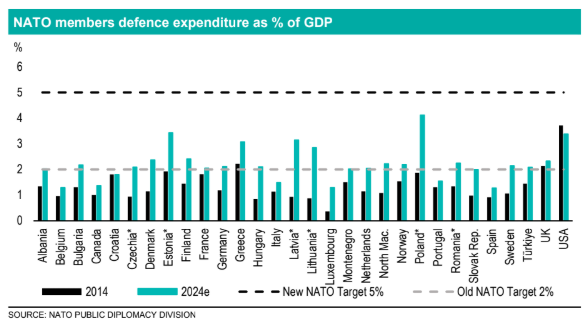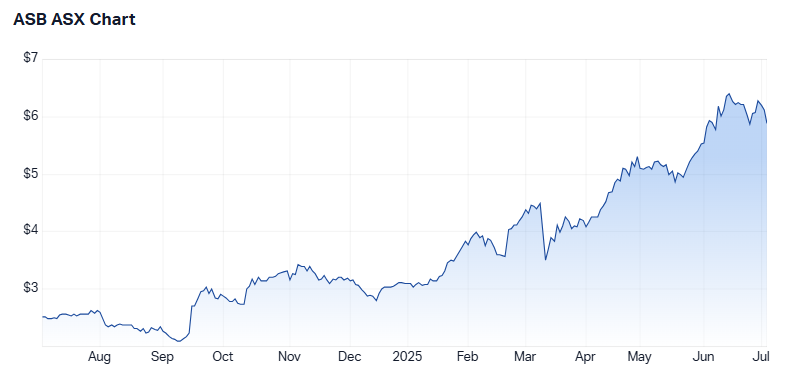A red-hot sector just got a major boost. Should you chase the rally?
.jpg)
Nothing makes governments pull money out of thin air faster than threats to their sovereignty... and a little coercion from Donald Trump.
That’s the backdrop to NATO allies’ plan to lift defence spending to 5% of GDP by 2035, a sharp step-up that reflects the return of great power politics and the push to modernise military capabilities.
But it’s not just about tanks, jets, and submarines anymore. That 5% also covers AI, cybersecurity, and fast-evolving technologies like drones. According to three leading fund managers, this shift is shaping up to be the start of a long-term investment theme worthy of a place in diversified growth portfolios.
Defence has always mattered to governments. But now, it’s starting to matter to investors too. And it’s not just the U.S. giants in focus. European players, ASX-listed mid-caps, and defence technology tech firms are all getting a closer look as the sector evolves.
To unpack the opportunity, we spoke with:
- James Tsinidis, Partner & Portfolio Manager, Munro Partners
- Marc Jocum, Senior Product and Investment Strategist, Global X Australia
- Lucas Goode, Portfolio Manager, IML
"A genuine long-term structural tailwind"
While the 5% GDP target has prompted debate around feasibility, managers agree on one thing: defence spending is rising, and the implications for listed companies are significant.
"The proposed NATO target of 5% of GDP could represent over US$3 trillion in cumulative defence-aligned investment by 2035, more than doubling the historical spending," says Jocum.
More dollars into the sector will act as a genuine long-term structural tailwind for defence contractors and suppliers, according to Goode.
"Even though it will probably take a long time for most countries to get there, and the 5% includes a considerable amount of fudging, it’s a clear indication that the West is rearming and defence spending is heading north," he says.
This is reflected in the latest NATO data, which shows that after years of lagging, many member countries are finally meeting - or exceeding - the 2% defence spending target at the end of 2024.

Defence spending is rising - and the bar just got higher. Source: NATO Public Policy Division, Bell Potter
Tsinidis agrees, pointing to the magnitude of potential budget expansion in Europe alone.
“By 2035, we expect around a US$1.3 trillion defence budget for Europe alone - compared to US$550 billion if they had stuck with 2%," he says.
Drones, cyber, and naval strength
The NATO 5% commitment isn't just a flat increase in traditional warfare assets. It is specifically broken down as follows:
- 3.5% for "core defence requirements" including missile systems, mechanised infantry, and heavy equipment.
- 1.5% to "protect critical infrastructure, defend networks, ensure civil preparedness and resilience, innovate, and strengthen the defence industrial base".
"At this stage, we see the main opportunity being within the 3.5% component, as this is where the equipment budgets sit," says Tsinidis.
Goode and Jocum say the structure of NATO’s package also opens the door to more diverse forms of exposure.
"In a global context, the extension of how NATO is spending its money broadens the opportunity set beyond conventional contractors to include enterprise software, cloud, and space-based systems," says Jocum, pointing to Palantir (NASDAQ: PLTR) as a winner in the software side of the equation.
Meanwhile, Goode notes:
"Conflicts in the Middle East and Ukraine have highlighted the urgent need for all NATO countries and allies to materially increase their drone warfare and counter-drone capabilities, with the likes of EOS and Droneshield big winners from this trend."
An ASX beneficiary few saw coming
For Australian investors, Austal (ASX: ASB) has been a standout beneficiary of the global naval buildout.
“We see further upside in both the United States and Australia from increased defence spending and an emphasis on naval capability, and there is scope for further expansion of the number programs delivered by Austal in Alabama given its favourable geographic location and status as the most modern shipyard in the US defence industrial base," says Goode.
That said, he doesn’t expect Austal to benefit from rising European spending, given its lack of presence on the continent.
While Austal has soared 95% in the past year, IML is concerned about whether the sector is now being driven by momentum rather than value.

“Entering 2025 and given the huge run-up globally in defence stocks we've lately been more inclined to take profits than add to our exposure in a sector that is currently trading more on momentum than fundamentals,” says Goode.
Time to be selective
Global X’s Defence Tech ETF (ASX: DTEC) has become one of Australia’s best-performing thematic funds, up nearly 60% since listing in October 2024, and Global X believes there's still room to run.
"It might be early innings and we may be entering a super-cycle," he says.
For that reason, Global X is calling on Australian investors to consider defence as a long-term allocation within the satellite sleeve of portfolios.
"A 5% to 10% allocation to a defence technology ETF could help investors capture this trend, particularly for Australian investors, given defence companies only account for less than 0.1% of the Australian market through a handful of companies," he says.
The Munro Global Growth Small & Mid Cap Fund currently has 15.6% invested in defence and security companies - its largest weighting by area of interest - and is staying nimble given the sector’s headline-grabbing surge.
"We still see opportunities in longer cycle stocks as they have lagged. For example, stocks involved in building planes or ships, as these revenues and earnings come in over a longer period of time, and this backdrop is not priced into all stocks yet," says Tsindis.
Stocks the fundies rate
Munro likes:
- Curtiss-Wright (NYSE: CW), a smaller-cap subcontractor to major U.S. primes, also benefiting from energy security tailwinds via its nuclear business in Eastern Europe
- Rheinmetall (ETR: RHM), Germany’s largest defence company, active in ammunition, vehicles, and now air defence
- Axon (NASDAQ: AXON), which produces Taser weapons and body cameras, supported by the rising focus on domestic law enforcement
Goode, while cautious of valuations due to the sector's run-up, rates:
- Codan (ASX: CDA), previously a top contributor for IML. "We like Codan's portfolio and regard management very highly but see the company as fully valued at these levels."
- EOS (ASX: EOS), a global leader in counter-drone technology
On the ETF side, Jocum notes some of the drivers: "Rheinmetall has been a major contributor to DTEC’s returns, benefiting from robust demand for armoured vehicles and munitions, and its recent inclusion in the Euro Stoxx 50 index reflects growing investor recognition of its strategic relevance."
"Palantir Technologies has surged on the back of major government contracts, including NATO acquiring Palantir’s AI-powered military system to use as part of battlefield operations."
A reason to be sceptical?
Many NATO nations needed a push from Trump to reach 2%. So how realistic is 5% - especially with Trump unlikely to be around in 2035 to preside over NATO?
Goode agrees there is a risk that the commitments don't translate into real dollars quickly enough to meaningfully boost earnings.
"The bigger risk is the snail-like speed at which Western countries move with their defence procurement," he says.
Tsinidis is optimistic, believing the target is credible within the largest, strongest economies. Germany, for instance, released its debt brake and last week approved a plan to spike its military spending and hit the 3.5% core NATO defence target by 2029.

Outside of Europe, it’s also important to recognise that large economies like Japan, Canada, and Australia are also lifting their defence budgets.
"We think the budget target is credible within the largest, strongest economies like Germany and the UK. There is some risk in countries like Italy, where the budgets are unfunded. Even if a country like Italy falls short, it is worth noting that they will likely prioritise equipment spending, which is where our portfolio companies are positioned," says Tsinidis.
The pace may vary from country to country, but all three fundies agree: the current geopolitical climate guarantees more spending, not less.
"While implementation will vary by nation, the direction of travel is clear — defence is no longer a discretionary budget item, but a sovereign priority," concludes Jocum.
1 topic
7 stocks mentioned
1 fund mentioned
3 contributors mentioned

